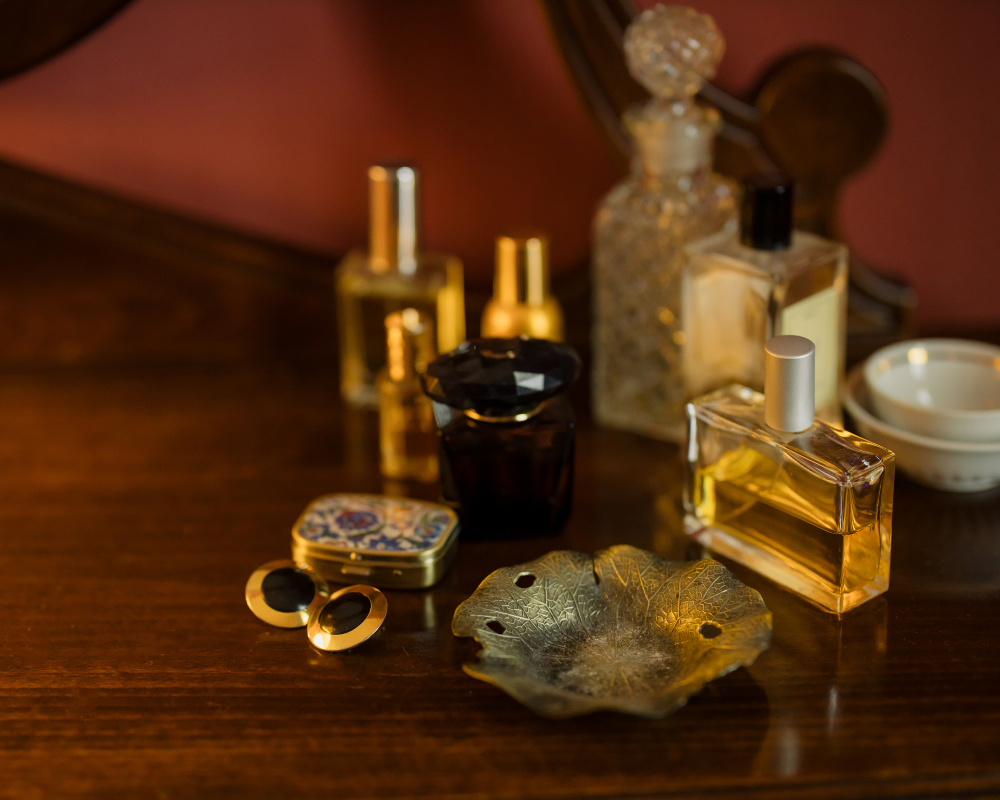How Perfume Is Made — From Raw Materials to Bottle

Perfume creation blends agriculture, chemistry, and art. Behind every finished fragrance are fields of flowers, labs full of molecules, and months of testing to balance beauty with safety and stability.
The perfumer’s palette: naturals and synthetics
- Naturals:
- Essential oils: obtained by distillation (e.g., lavender, rose otto, patchouli).
- Absolutes: solvent-extracted from delicate flowers that don’t distill well (e.g., jasmine, tuberose, orange blossom absolute).
- Resins and balsams: labdanum, benzoin, myrrh, frankincense.
- Woods and roots: sandalwood, cedar, vetiver.
- Synthetics (aroma chemicals):
- Expand the palette with notes that are rare, costly, or nonexistent in nature (e.g., aldehydes, ionones, musks, woody ambers like Ambroxan).
- Improve consistency, safety (e.g., cruelty-free musk), and performance (diffusion, longevity).
- Often derived from petrochemicals or biotech fermentation (e.g., santalols from clary sage–derived sclareol).
From field to essence: extraction methods
- Steam/hydro-distillation: Plant material is heated with steam; vapors are condensed to yield essential oil. Common for lavender, rosemary, rose (rose otto), vetiver.
- Expression (cold pressing): Mechanical pressing of citrus peels (bergamot, lemon, grapefruit). Phototoxic components (e.g., certain furocoumarins) may be reduced via “FCF” processing.
- Solvent extraction: Petals or resins are washed with solvents to create a “concrete,” then washed with alcohol to yield an “absolute.” Used for jasmine, tuberose, osmanthus, beeswax.
- Enfleurage (historical/rare today): Fat absorbs floral scent over days; washed with alcohol. Romantic but laborious; now used mainly by artisan producers.
- Supercritical CO2 extraction: Low-temperature, solvent-free method preserving delicate facets (used for vanilla, coffee, labdanum, ginger).
- Tincturing/maceration: Materials (e.g., vanilla beans, tonka) soaked in alcohol for weeks to months to create a nuanced extract.
- Headspace and GC/MS: The scent of a living flower or place is captured and analyzed; perfumers reconstruct it with naturals and synthetics.
From idea to formula: the creative process
- The brief: A brand or client sets a direction—story, target audience, price, ingredient constraints, and performance goals.
- Accords: Perfumers build small “chords” (e.g., a rose, a leather, a salty sea-breeze) and layer them to form the composition.
- Volatility and the “pyramid”:
- Top notes (fast): citrus, herbs, light fruits.
- Heart notes (medium): florals, spices, green notes.
- Base notes (slow): woods, resins, musks, ambers.
- Fixatives: Materials that slow evaporation and bind the structure (e.g., musks, ambers, resins, certain woods).
- Iteration: Dozens to hundreds of trials, evaluated on blotters and skin over hours to days. Analytical tools (GC/MS) help, but the nose decides.
Compounding, maturation, and bottling
- Compounding: Precise weighing of ingredients (often 30–150+), typically dissolved in high-proof cosmetic ethanol; for oils, carriers like dipropylene glycol or neutral oils are used.
- Concentrations:
- Extrait/Parfum: roughly 20–40% concentrate in alcohol.
- Eau de Parfum (EdP): ~15–20%.
- Eau de Toilette (EdT): ~8–15%.
- Eau de Cologne: ~2–5%.
- Oils, mists, and ancillaries vary widely.
- Maturation: The blend rests (days to weeks) so components integrate; chill and filtration remove waxes or particulates for clarity.
- Quality control: Stability testing (heat, light, time), clarity, color, odor profile, and spray performance; leaktightness and crimp checks for atomizers.
- Packaging: Glass bottles, pumps (crimp or screw), caps, and cartons co-designed for aesthetics, protection, and regulatory labeling.
Safety, compliance, and ethics
- IFRA Standards: Voluntary industry rules limiting or banning materials for safety (e.g., certain musks, high-atranol oakmoss).
- Cosmetic regulations: EU, US, and other markets require safety assessments and allergen disclosure above defined thresholds.
- Sourcing and biodiversity:
- CITES-restricted materials (e.g., agarwood/oud) require permits; many brands favor plantation-grown sandalwood and vetiver with verified traceability.
- Upcycling (e.g., using byproducts from citrus or timber) reduces waste.
- Animal-derived materials: Natural musk, civet, and ambergris are largely replaced or avoided; modern perfumery relies on synthetics and ethical sourcing.
Technology’s edge
- Biotech aroma ingredients via fermentation reduce environmental impact and batch variability.
- Headspace and data-driven tools expand creative options; still, artistry and cultural context guide final choices.
The people behind the perfume
- Perfumer (“nose”), evaluator, regulatory/toxicology specialists, lab and compounding technicians, quality assurance, packaging engineers, and supply-chain and marketing teams all shape the final product.
Where it’s made
- Historic hubs include Grasse (France), Geneva area (Switzerland), New York/New Jersey (US), Barcelona, Dubai, Mumbai, and Singapore—often near major fragrance houses and global logistics.
Article 2: Finding Your Signature Scent — How to Choose, Wear, and Care for Perfume
Choosing a perfume is part taste, part context, and part chemistry. This guide helps you decode styles, test intelligently, apply with finesse, and keep your fragrances fresh.
Know the basics
- Notes and evolution: Top (first impression), heart (character), base (trail). Expect the scent to change over 30–120 minutes.
- Sillage, projection, longevity:
- Sillage: the scent trail behind you.
- Projection: how far it radiates.
- Longevity: how long it lasts on skin/clothes.
- Concentration labels: Extrait/Parfum (rich), EdP (balanced), EdT (airy), Cologne (sheer). Strength varies by brand.
Fragrance families (what they smell like and why you might like them)
- Citrus: Bright, sparkling (bergamot, lemon, grapefruit). Great for heat, mornings, and clean moods.
- Aromatic/Herbal: Lavender, rosemary, sage; barbershop freshness or Mediterranean breeze.
- Floral:
- Soliflore (one-flower focus): rose, jasmine, tuberose, gardenia.
- Bouquets and white florals: lush, romantic, or opulent.
- Green: Crisp leaves, galbanum, cut grass; sporty and fresh.
- Fruity: Berries, peach, pear; playful and modern.
- Gourmand: Edible notes—vanilla, cocoa, caramel, coffee; cozy and indulgent.
- Woody: Cedar, sandalwood, vetiver; grounding, elegant, often long-lasting.
- Amber (formerly “oriental”): Warm resins, vanilla, spices; enveloping and sensual.
- Fougère: Lavender–coumarin–oakmoss accord; classic “barbershop” structure.
- Chypre: Citrus–moss–patchouli structure; refined, mossy, and sophisticated.
- Leather/Suede: Smoky to soft; evokes hides, tar, or fine handbags.
- Aquatic/Marine: Sea-breeze effects, watery fruits; airy and casual.
- Oud/Resinous: Incense, labdanum, and agarwood facets; rich and meditative.
How to test like a pro
- Shortlist: Start with 3–5 options. Too many tires your nose.
- Blotter first, then skin: If it intrigues you on paper, try one wrist (max two scents at once).
- Give it time: Smell at 5, 30, and 120 minutes to judge the drydown.
- Reset your nose: Fresh air or smelling your sleeve works better than coffee beans.
- Watch for anosmia: Some people are nose-blind to certain musks; if a scent “vanishes,” ask a friend if they can still smell it.
- Sample broadly: Try different families and don’t let “for men/for women” limit you—wear what you love.
Choosing for context
- Climate and season: Heat amplifies scent—choose fresher, lighter styles in summer; richer woods/ambers in cold weather.
- Occasion:
- Office/class: Clean, soft projection (citrus, light florals, subtle woods).
- Evenings/dates: Slightly bolder, with a pleasing trail (amber, gourmand, woods).
- Outdoors/sport: Crisp, breezy, or green.
- Mood and identity: Do you want comforting, energizing, mysterious, or polished? Let the vibe lead.
Application tips
- Where to apply: Pulse points (sides of neck, chest, wrists). Two to four sprays is plenty for most EdPs.
- Don’t rub (or do, with awareness): Rubbing won’t “break” molecules, but friction warms skin and can speed top-note evaporation. If you love the opening, dab gently instead.
- Hair and clothes: A light mist on hair or clothing boosts longevity, but test for staining and avoid delicate fabrics.
- Boost performance: Moisturize with an unscented lotion or matching body product before spraying.
Layering made simple
- Keep it to two compatible themes at first:
- Citrus + woody/amber to brighten.
- Rose + oud to deepen.
- Vanilla + tobacco to cozy up.
- Start with the heavier scent, add the brighter on top. Test on a small area before full wear.
Storage and care
- Enemies of perfume: heat, light, and oxygen. Store in a cool, dark place; keep bottles tightly closed and in their boxes if possible.
- Fridge? Acceptable if temperature is stable and condensation is minimized; avoid frequent temp swings.
- Shelf life: Many scents are freshest in the first 3–5 years. Signs of aging include darkening, cloudiness, or off-notes.
Troubleshooting
- “It doesn’t last on me”: Try moisturizing first, spraying on clothes, or choosing woods, musks, and ambers known for longevity. Consider a higher concentration (EdP/extrait).
- “It gives me a headache”: Use fewer sprays, choose softer profiles (green, airy floral, light citrus), and avoid overspraying in confined spaces.
- Skin sensitivity: Patch test and check allergen disclosures; avoid phototoxic citrus oils on sun-exposed skin unless labeled FCF.
Smart shopping and budget tips
- Sample sets and discovery kits let you explore affordably.
- Keep notes on what you try—likes, dislikes, and how it wore.
- Buy from trusted retailers; beware of counterfeits online.
- Decants are a cost-effective way to live with a scent before investing in a full bottle.
Ethics and sustainability
- Cruelty-free and vegan options are widely available; check brand policies.
- Naturals vs synthetics: Neither is inherently “better” or “safer”—judge by performance, ethics, and regulation.
- Look for responsible sourcing (e.g., Haitian vetiver, Australian sandalwood) and transparency around allergens and IFRA compliance.
